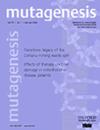区分基因毒性致癌物、非基因毒性致癌物和非致癌物的综合体外致癌性试验
IF 4.3
4区 医学
Q3 GENETICS & HEREDITY
引用次数: 0
摘要
化学品安全测试在产品和药物开发以及化学预防方面发挥着至关重要的作用;然而,体外遗传毒性安全测试并不总能准确预测体内致癌的化学品。如果化学品的体外基因毒性测试结果呈阳性,而体内测试结果呈阴性,就会造成不必要的动物试验,以确认错误的体外阳性结果。目前的体外测试通常只评估基因毒性终点,这限制了其检测非基因毒性致癌物的潜力。误导性体外阳性结果出现的频率可能很高,因此需要信息量更大的体外测试。现在人们认识到,多终点基因毒性测试有助于更准确地检测致癌物和非致癌物。本综述旨在评估我们的新型多终点体外测试的实用性,该测试使用多个癌症相关终点来预测致癌潜力。该工具评估了人类淋巴母细胞系 TK6 和 MCL-5 的微核频率、p53 表达、p21 表达、线粒体呼吸、细胞周期异常以及独特的细胞形态变化。这些终点用于观察细胞对以下类别中 18 种化学物质的反应:基因毒性致癌物、非基因毒性致癌物、毒性非致癌物以及误导性体外阳性和阴性制剂。在考虑每种化学品显著改变的终点数量的同时,还考虑了致癌综合特征得分,该得分由所有终点的折合变化总和得出。根据这些指标计算出总分后,致癌物质比非致癌物质表现出更强的效力。基因毒性致癌物通常比非基因毒性致癌物更强。因此,这种新方法在正确预测机制不明的化学品是否可能被视为致癌物方面显示出了潜力。总之,虽然建议进一步验证,但该测试显示了识别致癌化合物的潜力。采用这种方法可以减少致癌试验中动物的使用。本文章由计算机程序翻译,如有差异,请以英文原文为准。
An integrated in vitro carcinogenicity test that distinguishes between genotoxic carcinogens, non-genotoxic carcinogens, and non-carcinogens
Chemical safety testing plays a crucial role in product and pharmacological development, as well as chemoprevention; however, in vitro genotoxicity safety tests do not always accurately predict the chemicals that will be in vivo carcinogens. If chemicals test positive in vitro for genotoxicity but negative in vivo, this can contribute to unnecessary testing in animals used to confirm erroneous in vitro positive results. Current in vitro tests typically evaluate only genotoxicity endpoints, which limits their potential to detect non-genotoxic carcinogens. The frequency of misleading in vitro positive results can be high, leading to a requirement for more informative in vitro tests. It is now recognised that multiple-endpoint genotoxicity testing may aid more accurate detection of carcinogens and non-carcinogens. The objective of this review was to evaluate the utility of our novel, multiple-endpoint in vitro test which uses multiple cancer-relevant endpoints to predict carcinogenic potential. The tool assessed micronucleus frequency, p53 expression, p21 expression, mitochondrial respiration, cell cycle abnormalities and, uniquely, cell morphology changes in human lymphoblastoid cell lines, TK6 and MCL-5. The endpoints were used to observe cellular responses to 18 chemicals within the following categories: genotoxic carcinogens, non-genotoxic carcinogens, toxic non-carcinogens, and misleading in vitro positive and negative agents. The number of endpoints significantly altered for each chemical was considered, alongside the holistic Integrated Signature of Carcinogenicity score, derived from the sum of fold changes for all endpoints. Following calculation of an overall score from these measures, carcinogens exhibited greater potency than non-carcinogens. Genotoxic carcinogens were generally more potent than non-genotoxic carcinogens. This novel approach therefore demonstrated potential for correctly predicting whether chemicals with unknown mechanism may be considered carcinogens. Overall, while further validation is recommended, the test demonstrates potential for identification of carcinogenic compounds. Adoption of the approach could enable reduced animal use in carcinogenicity testing.
求助全文
通过发布文献求助,成功后即可免费获取论文全文。
去求助
来源期刊

Mutagenesis
生物-毒理学
CiteScore
5.90
自引率
3.70%
发文量
22
审稿时长
6-12 weeks
期刊介绍:
Mutagenesis is an international multi-disciplinary journal designed to bring together research aimed at the identification, characterization and elucidation of the mechanisms of action of physical, chemical and biological agents capable of producing genetic change in living organisms and the study of the consequences of such changes.
 求助内容:
求助内容: 应助结果提醒方式:
应助结果提醒方式:


